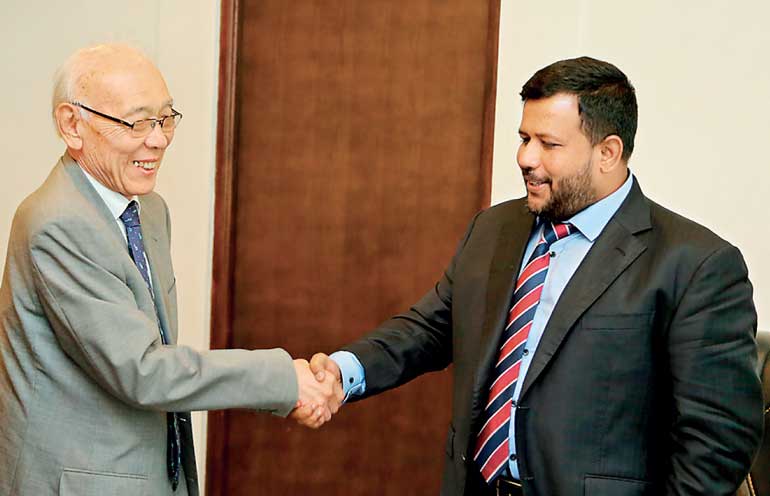Tuesday Dec 24, 2024
Tuesday Dec 24, 2024
Friday, 3 June 2016 00:00 - - {{hitsCtrl.values.hits}}
 AFKO Group GMEX Chairman Keun Young Lee and Minister of Industry and Commerce Rishad Bathiudeen
AFKO Group GMEX Chairman Keun Young Lee and Minister of Industry and Commerce Rishad Bathiudeen
In a new breakthrough in the ongoing revival saga of the historic Kankesanthurai (KKS) cement project, a South Korean conglomerate of global scale said it was vying to clinch the mega Northern project.
Interestingly, the Korean conglomerate is to enlist yet another gigantic Korean multinational for the required engineering services for the huge KKS project.
“We shall bring in all the necessary machineries and technology and can start from scratch; we only need Sri Lanka’s land and labour,” said Korea’s AFKO Group GMEX Chairman Keun Young Lee on 24 May.
Lee was addressing Minister of Industry and Commerce Rishad Bathiudeen during their meeting at the Ministry. Joining Chairman Lee were his top officials from Korea.
Lee’s AFKO Group, which merged to Korea’s multinational chaebol Hyundai Group in 2008, has its own construction and cement projects in Africa and elsewhere. Hyundai Motor Group has 18 affiliate firms with about $ 35 b turnover and is the second largest chaebol in South Korea.
“AFKO specialises in cement projects. We are keen to partner in the Kankesanthurai Cement Project and are ready to enter with $ 450 million as a start. We are not limited to KKS only; we are keen on cement production industries elsewhere in Sri Lanka, including Mannar. Our feasibility study team will visit Sri Lanka shortly to start assessments. We like to enlist Korean conglomerate Ssangyong C&T which ran more than 30 large projects abroad since 1990 as our main engineering company when we start KKS construction.”
The Ssangyong Group, at one time the fourth-largest South Korean conglomerate, reported annual sales around $ 20 b and has many subsidiaries under it. Singapore’s iconic Marina Bay Sands towers were a creation of Ssangyong Engineering & Construction, which is well known for landmark projects and a spin-off of Ssangyong Cement Industrial Co. Ltd.
Bathiudeen said: “We are pleased to hear of your interest in this critical project. Two global multinationals entering the KKS Cement project greatly enhances Sri Lanka’s manufacturing profile. Its importance is not only for our northern economy but for Sri Lanka’s overall manufacturing sector as well. The Government is looking for suitable global partners to revive the historic KKS Cement. We prefer credible firms – local or international – with good experience to partner in this project. The basic resources for this project are ready land and original site open in Kankesanthurai. We warmly welcome your technical assessment team to Sri Lanka and we shall extend our fullest support to prepare the feasibility report as well.”
The Lanka Cement factory at Kankesanthurai (‘KKS Factory’) was a pioneering northern industrial development project in the post-independent era. The KKS Factory commenced in 1950 under the Department of Industries and was converted to a public corporation in 1956, named Kankesan Cement Works.
Existence of limestone deposits in Kankesanthurai for cement production was a major incentive in establishing the factory in KKS. It is reported that the huge limestone deposits exceeding 80 million MT in the area is sufficient for the manufacturing of cement for another 100 years – even if they are extracted at a rate of 3,500 MT a day.
Previous news reports said that UAE-based Ras Al Khaimah Cement (RAKC) expressed interest in reviving the Kankesanthurai Cement Factory with a $ 100 million investment.
In 2011/12, a high-level decision was taken to amalgamate Sri Lanka Cement Corporation (SLCC) with Lanka Cement Ltd. (LCL). SLCC and LCL were jointly planning to resume bagging operations at Kankesanthurai factory.
The KKS factory closed its production in 1991 due to the then raging northern war. At the time of its closure, its production capacity was 115,000 MT and around 400 factory employees lost their livelihoods when it ceased operations.